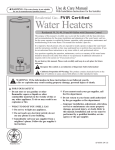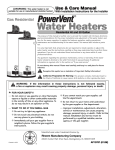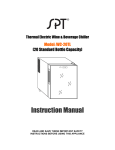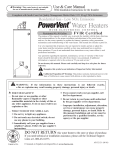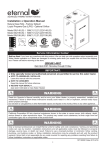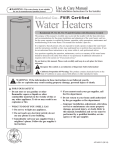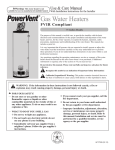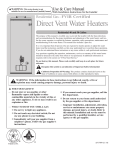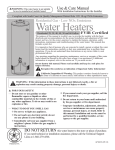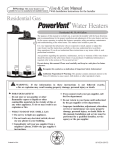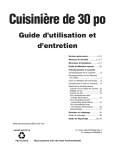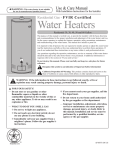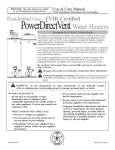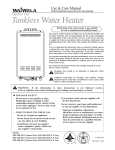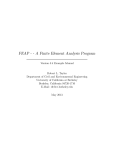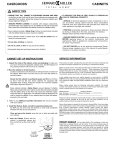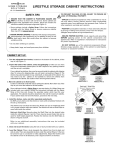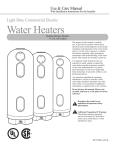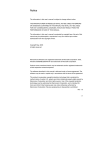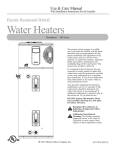Download Rheem XP50T06PV42U0 Instructions / Assembly
Transcript
! WARNING: This water heater is not suitable for use in manufactured (mobile) homes! Use & Care Manual With Installation Instructions for the Installer Residential Gas - FVIR Certified Water Heaters ® Residential 40 And 50 Gallon The purpose of this manual is twofold: one, to provide the installer with the basic directions and recommendations for the proper installation and adjustment of the water heater; and two, for the owner–operator, to explain the features, operation, safety precautions, maintenance and troubleshooting of the water heater. This manual also includes a parts list. It is very important that all persons who are expected to install, operate or adjust this water heater read the instructions carefully so they may understand how to perform these operations. If you do not understand these instructions or any terms within it, seek professional assistance. Any questions regarding the operation, maintenance, service or warranty of this water heater should be directed to the seller from whom it was purchased. If additional information is required, refer to the section on “If you need service.” Do not destroy this manual. Please read carefully and keep in a safe place for future reference. Recognize this symbol as an indication of Important Safety Information! Model on Right Shown With Factory Installed Optional Digital Display ! ! ! California Proposition 65 Warning: This product contains chemicals known to the State of California to cause cancer, birth defects or other reproductive harm. ARNING: If the information in these instructions is not followed exactly, a fire or W explosion may result causing property damage, personal injury or death. ! FOR YOUR SAFETY! — DO NOT store or use gasoline or other flammable vapors or liquids or other combustible materials in the vicinity of this or any other appliance. To do so may result in an explosion or fire. — WHAT TO DO IF YOU SMELL GAS ● DO NOT try to light any appliance. ● DO NOT touch any electrical switch; do not use any phone in your building. ● Immediately call your gas supplier from a neighbor’s phone. Follow the gas supplier’s instructions. ● I f you cannot reach your gas supplier, call the fire department. ●D O NOT return to your home until authorized by the gas supplier or fire department. — Improper installation, adjustment, alteration, service or maintenance can cause property damage, personal injury, or death. Refer to this manual. Installation and service must be performed by a qualified installer, service agency or the gas supplier. DESIGN Printed in USA CER TIFIED ® AP16882 (06/13) Safety Information Safety Precautions. . . . . . . 3–6 FOR YOUR RECORDS LP Gas Models . . . . . . . . . . . . 5 Write the model and serial numbers here: # Installation Instructions Location. . . . . . . . . . . . . . . . . . 7 Water Supply Connections. . . 9 Gas Supply. . . . . . . . . . . . . . . 11 # You can find them on a label on the appliance. Staple sales slip or cancelled check here. Proof of the original purchase date is needed to obtain service under the warranty. Venting. . . . . . . . . . . . . . . 12-19 Wiring Diagram. . . . . . . . 20-21 Pipe Insulation. . . . . . . . . . . . 22 Install User Display. . . . . 23-24 User Display Operation. . 25-27 Heat Traps . . . . . . . . . . . . . . . 28 Installation Checklist. . . . . . . 29 Potable/Space Heating . . . . 30 READ THIS MANUAL Inside you will find many helpful hints on how to use and maintain your water heater properly. A little preventive care on your part can save you time and money over the life of your water heater. You’ll find many answers to common problems in the Troubleshooting Guide. If you review the chart of Troubleshooting Tips first, you may not need to call for service. Operating Instructions Lighting Instructions. . . . . . 31 Water Temperature . . . . . 32-34 Care and Cleaning Draining. . . . . . . . . . . . . . . . 35 READ THE SAFETY INFORMATION Your safety and the safety of others are very important. There are many important safety messages in this manual and on your appliance. Always read and obey all safety messages. Maintenance. . . . . . . . . . . . . 35 ! Vent System Inspection. . . . 36 Burner Inspection . . . . . . . . 36 Extended Shut-Down. . . . . . 37 Troubleshooting Tips Before You Call For Service. . . . . . . . . . . . 38-40 Customer Service Parts List. . . . . . . . . . . . . . . . 41 If You Need Service . . . . . . . 44 This is the safety alert symbol. Recognize this symbol as an indication of Important Safety Information! This symbol alerts you to potential hazards that can kill or hurt you and others. All safety messages will follow the safety alert symbol and either the word “DANGER”, “WARNING”, “CAUTION” or “NOTICE”. These words mean: An imminently hazardous situation ! DANGER that will result in death or serious injury. ! WARNING ! A potentially hazardous situation that could result in death or serious injury and/or damage to property. CAUTION A potentially hazardous situation that may result in minor or moderate injury. NOTICE: Attention is called to observe a specified procedure or maintain a specific condition. 2 IMPORTANT SAFETY INFORMATION. READ ALL INSTRUCTIONS BEFORE USING. Be sure to read and understand the entire Use and Care Manual before attempting to install or operate this water heater. It may save you time and money. Pay particular attention to the Safety Instructions. Failure to follow these warnings could result in serious bodily injury or death. Should you have problems understanding the instructions in this manual, or have any questions, STOP, and get help from a qualified service technician, or the local gas utility. NOTICE: This water heater is equipped with a flammable vapor sensor that will automatically shut down the water heater in the presence of gasoline vapors and some other flammable vapors. If the flammable vapor sensor shuts down the water heater, contact a qualified service technician. Clear any hazardous materials and ventilate the area around the water heater. DO NOT turn off the appliance or adjust the ON/OFF switch in any way. DO NOT tamper with the flammable vapor sensor. Do not submerse the flammable vapor sensor in water. DO NOT allow the flammable vapor sensor to come into contact with any substances such as bleach or cleaners. See the “Gas Valve LED Error Code” Section of this manual for a list of error codes. DANGER! Install the Blower assembly and properly vent the water heater Failure to install the blower assembly and properly vent the water heater to the outdoors as outlined in the Venting Section of the Installation Instructions in this manual can result in unsafe operation of the water heater. To avoid the risk of fire, explosion, or asphyxiation from carbon monoxide, never operate this water heater unless it is properly vented and has an adequate air supply for proper operation. Be sure to inspect the vent system for proper installation at initial start-up; and at least annually thereafter. Refer to the Care and Cleaning section of this manual for more information regarding vent system inspection. WARNING! Gasoline, as well as other flammable materials and liquids (which include but are not limited to adhesives, solvents, paint thinners etc.), and the vapors they produce are extremely dangerous. DO NOT handle, use or store gasoline or other flammable or combustible materials anywhere near or in the vicinity of a water heater or any other appliance. Be sure to read and follow warning label pictured below and other labels on the water heater, as well as the warnings printed in this manual. Failure to do so can result in property damage, bodily injury or death. ! WA R N I N G FLAMMABLES Flammable Vapors FIRE AND EXPLOSION HAZARD ! Can result in serious injury or death. Do not store or use gasoline or other flammable vapors and liquids in the vicinity of this or any other appliance. Storage of or use of gasoline or other flammable vapors or liquids in the vicinity of this or any other appliance can result in serious injury or death. 3 IMPORTANT SAFETY INFORMATION. READ ALL INSTRUCTIONS BEFORE USING. ! DANGER! water temperature Setting Safety and energy conservation are factors to be considered when selecting the water temperature setting of a water heater’s gas control. Water temperatures above 125°F can cause severe burns or death from scalding. Be sure to read and follow the warnings outlined on the label pictured below. This label is also located on the water heater. Time/Temperature Relationship in Scalds ! DANGER Water Temperature Time To Produce a Serious Burn 120°F 125°F 130°F 135°F 140°F 145°F 150°F 155°F More than 5 minutes 11/2 to 2 minutes About 30 seconds About 10 seconds Less than 5 seconds Less than 3 seconds About 11/2 seconds About 1 second Table courtesy of Shriners Burn Institute HOT BURN Water temperature over 125° F can cause severe burns instantly or death from scalds. Children, disabled and elderly are at highest risk of being scalded. See instruction manual before setting temperature at water heater. Feel water before bathing or showering. Temperature limiting valves are available, see manual. NOTICE: Mixing valves are recommended for reducing point of use water temperature by mixing hot and cold water in branch water lines. It is recommended that a mixing valve complying with the Standard for Temperature Actuated Mixing Valves for Hot Water Distribution Systems, ASSE 1017 be installed. See pages 31 & 33 for more details and contact a licensed plumber or the local plumbing authority for further information. 4 The chart shown above may be used as a guide in determining the proper water temperature for your home. ! DANGER: Households with small children, disabled, or elderly persons may require a 120°F or lower gas control (thermostat) setting to prevent contact with “HOT” water. Maximum water temperatures occur just after the burner has shut off. To find water temperature being delivered, turn on a hot water faucet and place a thermometer in the water stream and read the thermometer. (See page 33 and 34 for more details.) The temperature of the water in the heater can be regulated by rotating the dial on the front of the gas control (thermostat). To comply with safety regulations the gas control (thermostat) was set at its lowest setting before the water heater was shipped from the factory. The illustration below details the approximate water temperature for each mark on the Gas Control (Thermostat) Temperature Dial. ! DANGER: Hotter water increases the potential for Hot Water SCALDS. Valve Set Point LOW ● ● ● HOT A B C VERY HOT Estimated Temperature 90°F 98°F 105°F 113°F 120°F 130°F 140°F 150°F 160°F Burns on Adult Skin --------------------------------------------------------------------------------------------More than 5 minutes About 30 seconds Less than 5 seconds About 1-1/2 seconds About 1/2 second DANGER! liquefied petroleum (LP Propane or butane) and Natural gas models LP and Natural gas have an odorant added to aid in detecting a gas leak. Some people may not physically be able to smell or recognize this odorant. If you are unsure or unfamiliar with the smell of LP or natural gas, ask the gas supplier. Other conditions, such as “odorant fade”, which causes the odorant to diminish in intensity, can also hide or camouflage a gas leak. ● Water heaters utilizing LP gas are different from natural gas models. A natural gas water heater will not function safely on LP gas and vice versa. ●N o attempt should ever be made to convert the water heater from natural gas to LP gas. To avoid possible equipment damage, personal injury or fire, do not connect the water heater to a fuel type not in accordance with the unit data plate. LP for LP units. Natural gas for natural gas units. These units are not certified for any other fuel type. ●L P appliances should not be installed below grade (for example, in a basement) if such installation is prohibited by federal, state and/or local laws, rules, regulations or customs. ●L P gas must be used with great caution. It is heavier than air and will collect first in lower areas making it hard to detect at nose level. ! DANGER: If a gas leak is present or suspected: ● DO NOT attempt to find the cause yourself. ● DO NOT try to light any appliance. ● DO NOT touch any electrical switch. ● DO NOT use any phone in your building. ● Leave the house immediately and make sure your family and pets leave also. ● Leave the doors open for ventilation and contact the gas supplier, a qualified service agency or the fire department. ● Stay away from the house (or building) until the service call has been made, the leak is corrected and a qualified agency has determined the area to be safe. ●B efore attempting to light the water heater, make sure to look and smell for gas leaks. Use a soapy solution to check all gas fittings and connections. Bubbling at a connection indicates a leak that must be corrected. When smelling to detect a gas leak, be sure to sniff near the floor also. ●G as detectors are recommended in LP & natural gas applications and their installation should be in accordance with the detector manufacturer’s recommendations and/or local laws, rules, regulations or customs. ● I t is recommended that more than one method, such as soapy solution, gas detectors, etc., be used to detect leaks in gas applications. 5 IMPORTANT SAFETY INFORMATION. READ ALL INSTRUCTIONS BEFORE USING. ! WARNING! For your safety, the information in this manual must be followed to minimize the risk of fire or explosion, electric shock, or to prevent property damage, personal injury, or loss of life. FOR INSTALLATIONS IN THE STATE OF CALIFORNIA California Law requires that residential water heaters must be braced, anchored or strapped to resist falling or horizontal displacement due to earthquake motions. For residential water heaters up to 52-gallon capacity, a brochure with generic earthquake bracing instructions can be obtained from: Office of the State Architect, 1102 Q Street, Suite 5100, Sacramento, CA 95814 or you may call 916-445-8100 or ask a water heater dealer. However, applicable local codes shall govern installation. For residential water heaters of a capacity greater than 52 gallons, consult the local building jurisdiction for acceptable bracing procedures. SAFETY PRECAUTIONS Have the installer show you the location of the gas shut-off valve and how to shut it off if necessary. Turn off the manual shut-off valve if the water heater has been subjected to overheating, fire, flood, physical damage or if the gas supply fails to shut off. ● Read this manual entirely before installing or operating the water heater. ● Use this appliance only for its intended purpose as described in this Use and Care Manual. ● DO NOT attempt to repair or replace any part of your water heater unless it is specifically recommended in this manual. All other servicing should be referred to a qualified technician. ● Be sure your appliance is properly installed in accordance with local codes and the provided installation instructions. Read and follow this Safety Information carefully. SAVE THESE INSTRUCTIONS 6 Installing the water heater This water heater must be installed in accordance with these instructions, local codes, utility company requirements, and/or in the absence of local codes, use the latest edition of the American National Standard/National Fuel Gas Code. A copy can be purchased from either the American Gas Association, 400 N. Capitol Street NW, Washington, DC 20001 as ANSI standard Z223.1 or National Fire Protection Association, 1 Batterymarch Park, Quincy, MA 02269 as booklet NFPA 54. Combustion Air Inlet Openings Max. 2.75” Flammable Vapor Sensor Diameter of water heater plus 2” min. The auxiliary catch pan installation MUST conform to local codes. NOTICE: DO NOT allow the catch pan to obstruct the flammable vapor sensor. NOTICE: DO NOT allow the flammable vapor sensor to become submerged in water. Make sure the catch pan is properly drained. Location The water heater should not be located in an area where leakage from the tank or connections will result in damage to the area adjacent to the heater or to lower floors of the structure. unless otherwise directed by State and Local code requirements. The water heater must be located so it is not subject to physical damage, for example, by moving vehicles, area flooding etc. When such areas cannot be avoided it is recommended that a suitable catch pan, adequately drained, must be installed under the water heater. ● We recommend this water heater be installed in locations where the ambient temperatures do not exceed 100°F (38°C). The water heater must be centered in the catch pan. IMPORTANT: DO NOT install the water heater in a location where it may be subjected to ambient temperatures exceeding 125°F (52°C). The catch pan must not restrict air flow to the combustion air inlet openings (perforation openings) located around the lower perimeter of the water heater. Catch pan kits are available from the store where the water heater was purchased, or any water heater distributor. Make certain the floor underneath the water heater is strong enough to sufficiently support the weight of the water heater once it is filled with water. A gas fired water heater or any other appliance should not be installed in a space where liquids which give off flammable vapors are to be used or stored. Such liquids include gasoline, LP gas (butane or propane), paint or adhesives and their thinners, solvents or removers. DO NOT block or obstruct any of the combustion air inlet openings located around the perimeter of the water heater. A minimum of 1” is required between these combustion air inlet openings and any obstruction. DO NOT obstruct or block the Flammable Vapor Sensor. ! WARNING: Combustible construction refers to adjacent walls and ceilings and should not be confused with combustible or flammable products and materials. Combustible and/or flammable products and materials should never be stored in the vicinity of this or any gas appliance. Because of natural air movement in a room or other enclosed space, flammable vapors can be carried some distance from where liquids which give off flammable vapors are to be used or stored. The open flame of the water heater’s pilot or main burner can ignite these vapors and create a shut down condition of the water heater which will not allow the water heater to ignite until examined by a Qualified Service Technician. FVIR certified gas water heaters can be installed on a residential garage floor without the use of an 18" stand in accordance with the National Fuel Gas Code, NFPA 54, ANSI Z223.1 2006, ● The water heater should be installed so as to minimize the length of plastic vent pipe and the number of vent connection fittings required. (Refer to the “INSTALLATION” Section of this manual.) ● Long hot water lines should be insulated to conserve water and energy. ● The water heater and water lines should be protected from exposure to freezing temperatures. ● Do not install the water heater in bathrooms, bedrooms, any occupied rooms normally kept closed, or in unprotected outdoor areas. ● Minimum clearance from combustible construction: Front 3” (7.6 cm) Sides 1” (2.5 cm) Rear 0” (0 cm) Top 12” (30.5 cm) If the clearances stated on the Instruction/Warning Label, located on the front of the heater differ, install the water heater according to the clearances stated on the label. ● I f the water heater is installed in an alcove or closet, the entire floor must be covered by a wood or metal panel. A minimum of 24” clearance from the front and top should be available for adequate inspection and servicing. ● The water heater may be installed on combustible floors, but not directly on carpeting. If the water heater must be installed on carpeting, place a metal or wood panel beneath the water heater, extending beyond its full width and depth at least 3” in all directions. 7 Installing the water heater Inspect Shipment Inspect the water heater for possible damage. Check the markings on the rating plate of the water heater to be certain the type of gas supplied corresponds to the water heater requirements. Combustion and Ventilation Air Proper operation of the water heater requires air for combustion and ventilation. Provisions for combustion and ventilation air must comply with referenced codes and standards. DO NOT block or obstruct any of the combustion air inlet openings located around the perimeter of the water heater. A minimum of 1” is required between these combustion air inlet openings and any obstruction. NOTICE: If the water heater is installed in an unconfined space within a building of conventional frame, masonry or metal construction, infiltration air is normally adequate for proper combustion and ventilation. If the water heater is installed in a confined space, provisions for combustion and ventilation air must be made. DO NOT obstruct or block the Flammable Vapor Sensor. A confined space is one having a volume of less than 50 cubic feet per 1000 Btuh of the aggregate input of all appliances within that space. The air must be supplied through two permanent openings of equal area. One is to be located within 12” above the floor and the other is to be located within 12” from the ceiling. The minimum net free area of each opening must not be less than one square inch per 1000 Btuh of the total input rating of all the appliances in the enclosure (but not less than 100 square inches), if each opening communicates with other unconfined areas inside the building. Buildings of unusually tight construction shall have the combustion and ventilation air supplied from outdoors, or a freely ventilated attic or crawl space. If air is supplied from outdoors, directly or through vertical ducts, there must be two openings located as specified above and each must have a minimum net free area of not less than one square inch per 4000 Btuh of the total input rating of all the appliances in the enclosure. If horizontal ducts are used to communicate with the outdoors, each opening must have a minimum net free area of not less than one square inch per 2000 Btuh of the total input rating of all the appliances in the enclosure. If ducts are used, the minimum dimensions of rectangular air ducts shall not be less than 3”. NOTICE: If the duct openings which supply combustion and ventilation air are to be covered with a protective screen or grill, the net free area (openings in the material) of the covering material must be used in determining the size of the openings. Protective screening for the openings MUST NOT be smaller than 1/4”mesh to prevent clogging by lint or other debris. Corrosive Atmospheres NOTICE: The water heater should not be installed near an air supply containing halogenated hydrocarbons. The air in beauty shops, dry cleaning establishments, photo processing labs, and storage areas for liquid and powdered bleaches or swimming pool chemicals often contain such halogenated hydrocarbons. An air supply containing halogenated hydrocarbons may be safe to breathe, but when it passes through a gas flame corrosive elements are released that will shorten the life of any gas burning appliance. 8 Propellants from common spray cans or gas leaks from A/C and refrigeration equipment are highly corrosive after passing through a flame. The water heater warranty is voided when failure of the heater is due to operation in a corrosive atmosphere. Thermal Expansion Determine if a check valve exists in the inlet water line. Check with your local water utility company. It may have been installed in the cold water line as a separate back flow preventer, or it may be part of a pressure reducing valve, water meter or water softener. A check valve located in the cold water inlet line can cause what is referred to as a “closed water system”. A cold water inlet line with no check valve or back flow prevention device is referred to as an “open” water system. As water is heated, it expands in volume and creates an increase in the pressure within the water system. This action is referred to as “thermal expansion”. In an “open” water system, expanding water which exceeds the capacity of the water heater flows back into the city main where the pressure is easily dissipated. A “closed water system”, however, prevents the expanding water from flowing back into the main supply line, and the result of “thermal expansion” can create a rapid and dangerous pressure increase in IMPORTANT: DO NOT apply heat to the HOT or COLD water connections. If sweat connections are used, sweat tubing to adapter before fitting adapter to the cold water connections on heater. Any heat applied to the cold water supply fittings will permanently damage the dip tube and heat traps. NOTICE: The National Fuel Gas Code (NFGC) mandates a manual gas shut-off valve: See (NFGC) for complete instructions. Local codes or plumbing authority requirements may vary from the instructions or diagrams provided and take precedent over these instructions. the water heater and system piping. This rapid pressure increase can quickly reach the safety setting of the relief valve, causing it to operate during each heating cycle. Thermal expansion, and the resulting rapid, and repeated expansion and contraction of components in the water heater and piping system can cause premature failure of the relief valve, and possibly the heater itself. Replacing the relief valve will not correct the problem! The suggested method of controlling thermal expansion is to install an expansion tank in the cold water line between the water heater and the check valve (see illustration below). The expansion tank is designed with an air cushion built in that compresses as the system pressure increases, thereby relieving the over pressure condition and eliminating the repeated operation of the relief valve. Other methods of controlling thermal expansion are also available. Contact your installing contractor, water supplier or plumbing inspector for additional information regarding this subject. Water Supply Connections Refer to the illustration below for suggested typical installation. The installation of unions or flexible copper connectors is recommended on the hot and cold water connections so that the water heater may be easily disconnected Typical Installation for servicing if necessary. The HOT and COLD water connections are clearly marked and are 3/4” NPT on all models. Install a shut-off valve in the cold water line near the water heater. Vent connector Union 1/4” per foot maximum slope up or down for horizontal venting. Heat trap 6” minimum Anode Blower assembly Hot water outlet to fixtures Transformer Box (Remote Control Models Only) Water Heater Jacket Temperature and pressure relief valve Remote Control Union (Factory Installed Option) Manual gas shut-off Heat trap 6” minimum To cold water supply Shut-off valve To gas supply Ground joint union Cap Drain valve Thermostatic gas valve Relief valve discharge line to suitable open drain. Combustion Air Inlet Openings Jacket door Flammable Vapor Sensor Auxiliary catch pan Shut-off valve Thermal expansion tank (if required) Sediment trap Drain Pan Pipe to suitable drain. 6” Air gap 9 Installing the water heater A new combination temperature and pressure relief valve, complying with the Standard for Relief Valves and Automatic Gas Shut-Off Devices for Hot Water Supply Systems, ANSI Z21.22, is supplied and must remain in the opening provided and marked for the purpose on the water heater. No valve of any type should be installed between the relief valve and the tank. Local codes shall govern the installation of relief valves. Relief Valve The pressure rating of the relief valve must not exceed 150 PSI, the maximum working pressure of the water heater as marked on the rating plate. The Btuh rating of the relief valve must equal or exceed the Btuh input of the water heater as marked on its rating plate. Position the outlet of the relief valve above a suitable open drain to eliminate potential water damage. Piping used should be of a type approved for hot water distribution. The discharge line must be no smaller than the outlet of the valve and must pitch downward from the valve to allow complete drainage (by gravity) of the relief valve and discharge line. The end of the discharge line should not be threaded or concealed and should be protected from freezing. No valve of any type, restriction, or reducer coupling should be installed in the discharge line. To Fill the Water Heater WARNING: The tank must be full of water before heater is turned on. The water heater warranty does not cover damage or failure resulting from operation with an empty or partially empty tank. Make certain that the drain valve is closed, then open the shut-off valve in the cold water supply line. Open each hot water faucet slowly to allow the air to vent from the water heater and piping. A steady flow of water from the hot water faucet(s) indicates a full water heater. Condensation Condensation can form on the tank when it is first filled with water. Condensation might also occur with a heavy water draw and very cold inlet water temperatures. Drops of water falling on the burner can produce a sizzling or pinging sound. This condition is not unusual, and will disappear after the water becomes heated. If, however, the condensation continues, examine the piping and fittings for possible leaks. 10 DO NOT allow the flammable vapor sensor to become submerged in water. WARNING: DO NOT attempt to convert this water heater for use with a different type of gas other than the type shown on the rating plate. Such conversion could result in hazardous operating conditions. Gas Supply The branch gas supply line to the water heater should be clean 1/2” black steel pipe or other approved gas piping material. A ground joint union or ANSI design certified semi-rigid or flexible gas appliance connector should be installed in the gas line close to the water heater. The National Fuel Gas Code (NFGC) mandates a manual gas shut-off valve: See (NFGC) for complete instructions. If flexible connectors are used, the maximum length shall not exceed 36” and must meet the requirements in ANSI Z21.24-Connectors for Gas Appliances. If lever type gas shut-offs are used, they shall be T-Handle type. Compound used on the threaded joints of the gas piping must be of the type resistant to the action of LP gas. Use compound sparingly on male threads only. Where a sediment trap is not Leak Testing WARNING: Never use an open flame to test for gas leaks, as property damage, personal injury, or death could result. The water heater and its gas connections must be leak tested at normal operating pressures before it is placed in operation. urn on the manual gas shut-off T valve near the water heater. se a soapy water solution to test U for leaks at all connections and incorporated as part of the appliance, a sediment trap shall be installed downstream of the equipment shutoff valve as close to the inlet of the appliance as practical at the time of the appliance installation. The sediment trap shall be either a tee fitting with a capped nipple in the bottom outlet or other device recognized as an effective sediment trap. DO NOT use excessive force (over 31.5 ft lbs.) in tightening the pipe joint at the gas control (thermostat) inlet, particularly if teflon pipe compound is used, as the valve body may be damaged. The inlet gas pressure to the water heater must not exceed 10.5” w.c. for natural gas, or 14” w.c. for LP gas. For purposes of input adjustment, the minimum inlet gas pressure (with main burner on) is shown on the water heater rating plate. If high or low gas pressures are present, contact your gas supplier for correction. fittings. Bubbles indicate a gas leak that must be corrected. The factory connections to the gas control (thermostat) should also be leak tested after the water heater is placed in operation. Pressure Testing the Gas Supply System The water heater and its manual gas shut-off valve must be disconnected from the gas supply piping system during any pressure testing of that system at pressures in excess of 3/8 psi (10.5” w.c.) for natural gas, or 1/2 psi (14” w.c.) for LP gas. WARNING: Failure to install a water heater suitable for the altitude at the location it is intended to serve, can result in improper operation of the appliance resulting in property damage and/or producing carbon monoxide gas, which could result in personal injury, or death. The water heater must be isolated from the gas piping system by closing the manual gas shut-off valve during any pressure testing of the gas supply piping at pressures equal to or less than 3/8 psi (10.5” w.c.) for natural gas, or 1/2 psi (14” w.c.) for LP gas. High Altitude Input rating of this water heater is based on sea level operation. At higher elevations the actual input rate may be lower than the value listed on the rating label due to the derating of natural gas and LP gas. This water heater can be installed at elevation up to the elevation listed on the rating plate attached to the water heater without any change or modification. Refer to the Venting Information tables on page 15 for maximum vent lengths. Contact the local gas supplier for more information. 11 Installing the water heater The water heater must be installed with the factory supplied blower assembly in place. Blower Assembly Blower Assembly Installation Rubber Coupling Flue Baffle Connect blower assembly with the electrical connector. Attach Blower Assembly to top pan using the six (6) screws provided (See diagram to the left). DO NOT overtighten screws to ensure plastic does not crack. Install rubber coupling (supplied in the box with water heater) on blower housing and secure it. NOTICE: The Blower Assembly is model specific and only the blower assembly supplied should be used on this water heater. Venting DANGER: Failure to install the blower assembly and properly vent the water heater to the outdoors as outlined in the Venting section of this manual will result in unsafe operation of the water heater causing bodily injury, explosion, fire or death. To avoid the risk of fire, explosion, or asphyxiation from carbon monoxide, NEVER operate the water heater unless it is properly vented and has adequate air supply for proper operation as outlined in the Venting section of this manual. The vent pipe must overlap a minimum of ½” on each connection. It is important that the vent pipe engages fully into any pipe fitting and be kept in that position until the adhesive has fully cured. DO NOT drill or punch holes in the plastic pipe or fittings. NOTICE: This unit is equipped with a Flammable Vapor Sensor. DO NOT apply power until enough time has passed to allow the vapors from the primer and cement to dissipate. 12 The water heater must be vented to the outdoors as described in these instructions. DO NOT connect this water heater to an existing vent or chimney - it must be vented separately from all other appliances. The unit may be vented horizontally through a wall or vertically through the roof. Vent pipe runs must be adequately supported along both vertical and horizontal lengths. Maximum unsupported length is recommended to be no more than 6 feet. It is imperative that the first hanger be located on the horizontal length immediately adjacent to the first 90-degree elbow from the vertical rise of vent pipe connected to the water heater. The support method used should isolate the vent pipe from floor joists or other structural members to help prevent the transmission of noise and vibration. Do not support, pin or otherwise secure the venting system in a way that restricts the normal thermal expansion and contraction of the chosen venting material. If the water heater is being installed as a replacement for an existing power vented water heater, a thorough inspection of the existing venting system must be performed prior to any installation work. Verify that the correct materials as detailed above have been used, and that the minimum or maximum vent length and terminal locations as detailed in this manual have been met. Carefully inspect the entire venting system for any signs of cracks or fractures, particularly at the joints between elbows or other fittings and the straight length of vent pipe. Check the system for signs of sagging or other stresses in the joints as a result of misalignment of any components in the system. If any of these conditions are found, they must be corrected in accordance with the venting instructions in this manual before completing the installation and putting the water heater into service. NOTICE: The vent piping must be connected to the blower assembly using the rubber coupling and supplied clamps. The vent pipe connections at the blower assembly must be leak tested with soap and water solution upon initial startup. Repair any leaks before allowing the water heater to operate. Additional installation information for The Commonwealth of Massachusetts is located on the back page of this manual. G v H A D E V B B B RA OPE C V L LE RAB OPE F I v B A M X K X v B v v ED FIX D SE CLO v ED FIX ED S CLO v BLE J B V Vent Terminal X Air Supply Inlet Area Where Terminal Is Not Permitted US Installations A - Clearance above grade, veranda, porch, 12 in. (30 cm) deck or balcony B - Clearance to window or door that may be 4 ft. (1.2 m) below or to side of opening; 1 ft (300 m) above opened opening C - Clearance to permanately closed window * D - Vertical clearance to ventilated soffit * located above the terminal within a horizontal distance of 2 feet (61 cm) from the center line of the terminal E - Clearance to unventilated soffit * F - Clearance to outside corner * G - Clearance to inside corner * H - C learance to each side of centerline * extended above meter/regulator assembly I - Clearance to service regulator vent outlet * J - Clearance to nonmechanical air supply in- 4 ft. (1.2 m) below or to side of opening; 1 ft (30 cm) above let to building or the combustion air inlet opening to any other appliance K - C learance to a mechanical air supply 3 ft. (91 cm) above if within 10 ft. (3 m) horizontally inlet L - Clearance above paved sidewalk or * paved driveway located on public property M - Clearance under veranda, porch, deck, * or balcony 1 1 In accordance with the current ANSI Z223.1/NFPA 54 National Fuel Gas Code * For clearances not specified in ANSI Z223.1/ NFPA 54 the following statement shall be included: "Clearance in accordance with local installation codes and the requirements of the gas supplier and the manfacture's installation instructions" 13 Installing the water heater Vent Pipe Materials NOTICE: This unit can be vented using only the following recommended pipe material. Use only 2- or 3-inch diameter pipe. DO NOT mix ABS pipe and fittings with PVC or CPVC pipe fittings. Note: It is acceptable to interchange PVC and CPVC pipe and fittings. PVC (Schedule 40, ASTM D1785) NOTE: This water heater may be installed in attics provided ambient temperatures do not exceed 125°F (52°C) and CPVC or ABS pipe and fittings are used for the entire vent system. CPVC (Schedule 40, ASTM F441) ABS (Schedule 40, ASTM D2661) ABS (Schedule 40 DWV, Cellular Core, ASTM F628) The fittings, other than the TERMINATION, should be equivalent to the following: PVC (Schedule 40 DWV, ASTM D2665) Vent pipe materials must be chosen based upon the ambient temperature where the water heater is installed and the location within the vent system. See chart below for material requirements. CPVC (Schedule 40, ASTM F438) ABS (Schedule 40 DWV, ASTM D2661) Ambient Installation Temperatures and Vent System Material Specifications 14 Models Below 100°F (38°C) 0 to Max. ft. (0 to Max. m) Equivalent Vent| System Length 100°F (38°C) to 125°F (52°C) 0 to 10 ft. 10 ft. to Max. (0 to 3 m) (0 m to Max.) Equivalent Vent Equivalent Vent System Length System Length 40 and 50 Gallon PVC, CPVC or ABS CPVC or ABS PVC, CPVC or ABS Condensate Management and Vent Risers There is no condensate collection and disposal required for Rheem water heaters under most conditions. Installations where the vent run is short or it runs through conditioned space in the home, such as basements or interior walls, do not typically cause condensation and will not require any condensation disposal methods regardless of vent pipe slope. Figure 1 shows the recommended vent pipe slope of no less than 1/8 inch per foot away from the water heater. Any condensation in the venting system will drain toward the vent termination. The blower pipe coupling features a capped drain port which is not needed in this case. CAUTION: Make sure drain port cap is securely in place. • • DO NOT drain over public way or walkway. Refer to local codes for any condensate requirements. From Drain Port Water Filled Wire or Zip Ties To Drain Slope Away FigureFigure 3 3 If the venting system is vertical and condensation handling is required, then the blower coupling drain port and tube must be used as described previously. Any horizontal portion of the vent pipe must slope toward the water heater at a minimum of 1/8 inch per foot so a water trap is not created. See Figures 4 & 5 as examples of a vertical installations with condensation removal tube and trap. Drain Port with Cap FigureFigure 1 1 There are vent piping configurations, when combined with certain environmental conditions that can produce enough condensate to require collection and disposal. When a slope away from the water heater cannot be achieved and condensate handling is required in a horizontal vent system, the vent pipe should be sloped toward the water heater as shown in Figure 2. NOTICE: Vent riser fittings and pipe must be included in the total vent length calculation as described in the manual. Slope Toward Figure 4 4 Figure Drain Port Trap To Drain Figure 2 • • • • • • • • Figure 2 Remove drain port cap. Connect flexible condensate drain tube to the blower drain port. Loop the drain tube so that it has a circular trap. See Figure 3. Secure the top and bottom of the loop with wire ties or plastic zip ties as shown. DO NOT restrict any portion of the circular drain tube. Loop must be smooth and not collapse the tube. Fill circular drain tube with water to make sure combustion gases cannot vent into the room. Condensation collected must be discharged per local codes. Figure 5 Figure 5 A vent riser is used when the vent termination cannot be located above grade or snow lines. Power vented water heaters installed with a vent riser should have a slope toward the water heater if the venting is long and passes through unconditioned spaces. It is recommended that these installations have the condensate collection and disposal method defined previously. Figure 6 shows a condition where a vent riser is necessary to meet the minimum clearance. Note that the vent pipe must slope back to the water heater so that a water trap is not created at the outside 90 degree elbow. FigureFigure 6 6 15 Installing the water heater Maximum and Minimum Vent Lengths for Residential 40 & 50 Gallon Power Vents Minimum vent length for 2”vent pipe is one (1) foot of vertical pipe, one (1) 90°elbow, and three (3) feet of horizontal pipe. Maximum Venting information for 2” Vents* Maximum Vent Pipe Maximum Vent Pipe Length in Feet (ft) Length in Feet (ft) 0’ - 2,000’ 2,001’ and above. Number of 90° elbows with Vent Number of 45° Elbows One (1) None 44’ 24’ One (1) One (1) 41’ 21’ Two (2) None 38’ 18’ Two (2) One (1) 35’ 15’ Three (3) None 32’ 12’ * For the 2” vent, one 90° elbow is approximately equal to 6 feet of vent pipe. One 45° elbow is approximately equal to 3 feet of vent pipe. NOTICE: The mixing of 2" and 3" vent pipe is not recommended. If 3" pipe is used, a 2" to 3" reducer fitting is recommended at the rubber coupling. This water heater is supplied with a two-inch Schedule 40 PVC 45° vent terminal. When venting with 3" pipe, a Schedule 40 PVC 45° vent terminal must be used. Screens for both 2" and 3" vent terminals have been included. Minimum vent length for 3” vent pipe is one (1) foot of vertical pipe, one (1) 90°elbow, and four (4) feet of horizontal pipe. Maximum Venting information for 3” Vents** Number of 90° elbows with Vent One (1) One (1) Two (2) Two (2) Three (3) Three (3) Four (4) Four (4) Five (5) Number of 45° Elbows None One (1) None One (1) None One (1) None One (1) None Maximum Vent Pipe Length in Feet (ft) 0’ - 2,000’ 95’ 92.5’ 90’ 87.5’ 85’ 82.5’ 80’ 77.5’ 75’ Maximum Vent Pipe Length in Feet (ft) 2,001’ and above. 75’ 72.5’ 70’ 67.5’ 65’ 62.5’ 60’ 57.5’ 55’ ** F or the 3” vent, one 90° elbow is approximately equal to 5 feet of vent pipe. One 45° elbow is approximately equal to 2.5 feet of vent pipe. 16 Additional Venting Requirements Installations requiring less than one (1) foot of vertical pipe before the first elbow, subtract six (6) feet from the maximum vent length. Less than 1 ft. vertical pipe before first elbow Minimum Vent Restrictor Install the vent restrictor only at the minimum vent lengths listed on page 15 for the model numbers listed below. 43VP40S(P)E2(-E) PVP40S(P)E2(-E) 6GR40SPVE2 43VP50S(P)E2(-E) PVP50S(P)E2(-E) 6GR50SPVE2 Vent Pipe Mesh Vent Restrictor Vent Terminal DO NOT use the vent restrictor for any other vent lengths or on tall models. Additional PVC Fittings Considerations Do Not Use Short Sweep 90° Elbow Good Standard 90° Elbow Best Long Sweep 90° Elbow 17 Installing the water heater NOTICE: All pipe, fittings, solvent cement, primers and procedures must conform to American National Standards Institute and American Society for Testing and Materials (ANSI/ASTM) standards. Horizontal Vent Terminal Location The location of the vent terminal depends on the following minimum clearances and considerations (see illustration): Vent Terminal must be at least twelve (12) inches above grade level and above normal snow levels. Soffit vents 4' 4' Inside corner Electric meter 4' 18" 4' 18" 4' 3' above if within 10' Fresh air intake 12" (Above grade/snow level) window or vent Vent Terminal must be at least four (4) feet below, or four (4) feet horizontally from any door, operable window, soffit, under eave vent or gravity air inlet to the building or other appliances, or from gas or electric meters. Do not locate vent above walkways, doors, windows, air inlets, gas or electric meters or other equipment. Vent Terminal must be at least three (3) feet above any forced air inlet located within ten (10) feet. Any fresh or make-up air inlet such as for a dryer or furnace area is considered to be a forced air inlet. Vent Terminal must be at least eighteen (18) inches from an inside corner formed by two exterior walls. Additional Considerations DO NOT install vent terminal under any patio or deck. Caulk To help prevent moisture from freezing on walls and under eaves, do not locate vent terminal on the side of a building with prevailing winter winds. Rising moisture will collect under eaves Inside corner If soffit vent is too close, block off and install new vent at another location 6' Caulk 6' caulk zone 4' 6' (1.83 m) caulk zone or to edge of window etc., starting within 6' When terminating the vent pipe through brick or masonry surfaces, a rust-resistant sheet metal backing plate behind the vent termination is recommended. (See illustration.) Caulk 2 ft. sheet metal metal plate 2 ft. sq.sq.sheet plateonon brick or brick orsurface masonaryissurface is recomended. masonry recommended. WARNING : Moisture in the flue gas will condense as it leaves the vent terminal. In cold weather this condensate can freeze on the exterior wall, under the eaves and on surrounding objects. Some discoloration to the exterior of the building is to be expected. However, improper location or installation can result in severe damage to the structure or exterior finish of the building 18 DO NOT locate vent terminal too close to shrubbery, as flue gasses may damage them. Caulk all cracks, seams and joints within six (6) feet of vent terminal. All painted surfaces should be primed to lessen the chance of physical damage. Painted surfaces will require maintenance. Insulate vent pipe exposed to cold conditions (attics, crawl spaces, etc.) with inflammable material to help prevent moisture from accumulating in vent pipe. DO NOT extend exposed vent pipe outside of building. I f other vent terminal configurations are required, See "If You Need Service" section. NOTICE: All pipe, fittings, solvent cement, primers and procedures must conform to American National Standards Institute and American Society for Testing and Materials (ANSI/ASTM) standards. 2' x 2' Sheet Metal Shieldon Brick or Masonry Walls ent Terminal V with 1/2" Mesh Protective Screen Inside Vent Pipe From Water Heater Horizontal Vent Installation Once the vent terminal location has been determined, make a hole through the exterior wall to accommodate the vent pipe. Vent pipe must exit exterior wall horizontally only. Insert a small length of vent pipe through the wall and connect the coupling as shown to the left. Place the 1/2" mesh metal screen inside the terminal fitting and connect it as shown to the vent pipe on the exterior of the building. Pipe Coupling Outside of Building Wall Complete the rest of the vent pipe installation to the water heater's vent connector fitting on the blower outlet. If necessary support horizontal run as previously mentioned. Vertical Vent Termination Location Insert 1/2" Mesh Protective Screen Inside Terminal Elbow Short Piece of Vent Pipe The location of the vent terminal depends on the following minimum clearances and considerations (see illustration): Minimum twelve (12) inches above roof. Minimum twelve (12) inches above anticipated snow level. Maximum twenty-four (24) inches above roof level without additional support for vent. Vent Pipe Through Roof Min. 12" Above Roof Min. 12" Above Anticipated Snow Level. Elbow Vent Terminal Max. 24" Above Roof (Without Additional Support) Four (4) feet from any gable, dormer or other roof structure with building interior access (i.e., vent, window, etc.). Ten (10) feet from any forced air inlet to the building. Any fresh or make-up air inlet such as a dryer or furnace area is considered to be a forced air inlet. Vertical Vent Installation Once the vent terminal location has been determined, make a hole through the roof and interior ceiling to accommodate the vent pipe. Determine the vent terminal height and cut vent pipe accordingly. Refer to the above section for proper vent terminal height. Complete the vent pipe installation to the water heater's vent connector fitting on the blower outlet. Connect vent elbow onto vertical pipe through roof. Support vertical or horizontal lengths as previously mentioned. Install adequate flashing where the vent pipe passes through the roof. Connect short piece of vent pipe (approximately 3" long) to elbow, then insert 1/2" mesh metal screen into terminal elbow and join it to the short piece of vent pipe. 19 Installing the water heater NOTICE: All pipe, fittings, solvent cement, primers and procedures must conform to American National Standards Institute and American Society for Testing and Materials (ANSI/ASTM) standards. Cementing Joints WARNING: DANGER OF FIRE OR BODILY INJURY - Solvent cements and primers are highly flammable. Provide adequate ventilation and DO NOT assemble near heat source or open flame. DO NOT smoke. Avoid skin or eye contact. Observe all cautions and warnings on material containers. CAUTION: For proper installation: DO NOT use solvent cement that has become curdled, lumpy or thickened. DO NOT thin solvent cement. Observe shelf precautions printed on the containers. For applications below 32°F use only low temperature type solvent cement. Appropriate solvent and cleaner must be used for the type of vent pipe used (PVC, CPVC or ABS). 20 All joints in the vent piping must be properly sealed and the following materials are recommended: PVC materials should use ASTM D2564 grade cement. CPVC materials should use ASTM F493 grade cement. ABS materials should use ASTM D2235 grade cement. Cleaner-Primer and Medium Body Solvent Cement: ut pipe end square, remove jagged C edges and burrs. Chamfer end of pipe, then clean fitting socket and pipe joint area of all dirt, grease or moisture. After checking pipe and socket for proper fit, wipe socket and pipe with cleaner-primer. Apply a liberal coat of primer to inside surface of socket and outside of pipe. DO NOT allow primer to dry before applying cement. Apply a thin coat of cement evenly in the socket. Quickly apply a heavy coat of cement to the pipe end and insert pipe into fitting with a slight twisting motion until it bottoms out. NOTICE: Cement must be fluid; if not, recoat. Hold the pipe fitting for 30 seconds to prevent the tapered socket from pushing the pipe out of the fitting. Wipe all excess cement from the joint with a rag. Allow 15 minutes before handling. Cure time will vary according to fit, temperature and humidity. NOTICE: Stir the solvent cement frequently while using. Use a natural bristle brush or the dauber supplied with the can. The proper brush size is one inch. NOTICE: This unit is equipped with a Flammable Vapor Sensor. DO NOT apply power until enough time has passed to allow the vapors from the primer and cement to dissipate. Wiring If local codes permit, the water heater may be connected to electric service with the power cord provided (DO NOT use an extension cord). A grounding receptacle is required. The water heater must be electrically grounded in accordance with local codes, or, in the absence of local codes, in accordance with latest edition of the National Electric Code ANSI/NFPA No. 70. Refer to the figures below for water heater internal wiring. If local codes do not permit the use of cord connections, a 120 V, 50/60 Hz power supply, with suitable disconnecting means, must be connected to the black and white leads in the heater control enclosure. NOTICE: It is not recommended that this unit be installed on a GFCI circuit. A knock-out hole is provided to permit use of conduit or metal-clad cable connectors. The maximum current draw is approximately 5.0 amps. Diagram Without Optional Electronic Display CONNECTION DIAGRAM SCHEMATIC H N < PRESSURE SWITCH > 120 VAC BK = BLACK BL = BLUE G = GREEN R = RED W = WHITE Y = YELLOW INDUCER P1 MOT 1 2 3 4 5 TEMPERATURE SWITCH PS 3 x 2 CONNECTOR R Y W BK 120 VAC GROUND 120 NEUTRAL G BK BK WV 4460E CONTROL P3 BL 5 4 3 2 1 TS1 1 2 3 FV P2 TS TS2 FV 1 2 E1 TS2 W TS1 1 2 3 1 1 2 W GND PILOT ELECTRODE ASSY 1 SPARK N G H N H CAUTION! Label all wires prior to disconnection when servicing controls. Wiring errors can cause improper and dangerous operation. VERIFY PROPER OPERATION AFTER SERVICING! 21 Installing the water heater Diagram With Optional Electronic Display CAUTION! Label all wires prior to disconnection when servicing controls. Wiring errors can cause improper and dangerous operation. VERIFY PROPER OPERATION AFTER SERVICING! 22 Insulation Blankets WARNING: If local codes require external application of insulation blanket kits the manufacturer’s instructions included with the kit must be carefully followed. Insulation blankets, available to the general public, for external use on gas water heaters are not necessary. The purpose of an insulation blanket is to reduce the standby heat loss encountered with storage tank heaters. This water heater meets or exceeds the National Appliance Energy Conservation Act standards with respect to insulation and standby loss requirements making an insulation blanket unnecessary. The manufacturer’s warranty does not cover any damage or defect caused by installation, attachment or use of any type of energy saving or other unapproved devices (other than those authorized by the manufacturer) into, onto or in conjunction with the water heater. The use of unauthorized energy saving devices may shorten the life of the water heater and may endanger life and property. The manufacturer disclaims any responsibility for such loss or injury resulting from the use of such unauthorized devices. CAUTION: If local codes require the application of an external insulation blanket to this water heater, pay careful attention to the following so as not to restrict the proper function and operation NOTICE: If pipe insulation is used, ensure that the thickness does not exceed ½”. Insulation thicker than ½” can interfere with the Blower Assembly Dilution Air Holes. of the water heater: DO NOT cover the operating or warning labels attached to the water heater or attempt to relocate them on the exterior of insulation blanket. DO NOT apply insulation to the top of the water heater. This will interfere with the safe operation of the blower assembly. DO NOT cover the burner access door, jacket door, gas control (thermostat)/gas valve or pressure and temperature relief valve. DO NOT apply insulation to the bottom of the water heater or the area where the combustion air inlet openings and Flammable Vapor Sensor are located. This area must be unobstructed so as not to restrict combustion air flow to the burner or operation of the sensor. Inspect the insulation blanket frequently making certain it has not sagged and it is not restricting the air flow to the combustion air inlet openings (perforation holes) or the Flammable Vapor sensor located around the lower perimeter of the water heater jacket. This could result in an unsafe operating condition. Hot and Cold Pipe Insulation Installation Tall Model Blower Shown Short Model Blower Shown Dilution Air Intake Typical vertical piping arrangement For increased energy efficiency, some water heaters have been supplied with two 24” sections of pipe insulation. Typical horizontal piping arrangement Please install the insulation, according to the illustrations above, that best meets your requirements. T&P Insulation Installation For increased energy efficiency, this water heater has been supplied with a 2 3/8” section of T&P insulation. Please install the insulation as shown below. Typical Side Connect T & P Arrangement. Slip the insulation cover over the T&P Valve through the center hole and align the hole in the side with the opening of Typical Top Connect T & P Arrangement. the T&P Valve. Ensure the T&P Valve opening is not obstructed by the insulation. 23 Installing the Optional User Display The following instructions apply only to water heater models factory supplied with the electronic display option. IMPORTANT NOTICE: This electronic display cannot be added to a water heater not supplied from the factory with an electronic display. NOTICE: DO NOT over tighten to avoid cracking plastic enclosure. Mounting Holes for Transformer Components supplied with user display models: a. O ptional Water Heater Mounting Bracket – AP14752 f. User Display – AP14697 4. D etermine where the User Display will be located. The display can be attached to the water heater jacket with supplied Water Heater Mounting Bracket or mounted remotely to a wall via the wall plate up to 100 feet away using 18 AWG solid copper thermostat wire. Any installation location over 12 feet from the water heater will require additional thermostat wire. (Not supplied.) Installation Instructions: 5. If remote mounting, go to step 19. ! CAUTION: Turn the switch on the blower to the “off” position and disconnect power to the water heater before proceeding! 6. C ut enough thermostat wire from the 12 feet provided to connect the front mounted display to the Transformer Enclosure located on the top pan. b. 12 feet, 18 AWG Thermostat Wire – AP14820 c. Optional Mounting Tape – AP14819 d. Transformer Enclosure – AP14875 e. Screw, #8 x ½" Self Drilling Qty 2 AP5925GS 1. L ocate the electrical connection for the Transformer Enclosure on the top of the water heater. This electrical connection features a white 6-pin plug and white heat shrink. (Blower may be different in appearance) Transformer Pin Plug 7. S trip ½” insulation from the 3 wires on both ends. The wire provided is standard 3-wire with the colors GREEN, RED and WHITE. 8. C onnect one end of the wire to the Transformer Enclosure spring terminal strip. From left to right colors shall be GREEN – RED – WHITE. Wires should easily insert into the terminal strip. If required for wire insertion or removal, use small flat blade screw driver to press the tab located below each wire hole. 9. R emove two strips of Display Mounting Tape and attach to the inside flanges of the Water Heater Mounting Bracket. Display Mounting Tape Strips 2. T he Transformer Enclosure features a 6-pin connection located on the circuit board inside the enclosure. Attach the top pan harness connector to this 6-pin connector in the correct orientation. Flange of Mounting Bracket Six (6) Pin Connection for to Circuit Board 24 3. L ocate the two screw pilot holes on the water heater top to attach the Transformer Enclosure to the top pan. Position the enclosure so the terminal strip opening is visible from the front of the water heater. Secure enclosure to top pan with screws provided in the User Display Mounting Kit without pinching any wires. Water Heater Mounting Braket for Display 10. T he Water Heater Mounting Bracket features a wiring slot on the top flange and an opening for the wire. Pass the thermostat wire though the Water Heater Mounting Bracket opening. 11. Clean any dust or dirt from water heater jacket to allow proper tape adhesion. 12. R emove tape backing and carefully attach to the heater jacket above the Rheem logo. Allow the thermostat wire to be positioned in the wire slot located on the bracket top flange. 15. Replace battery cover. 16. A ttach display wall plate to heater bracket using the two #6 x ½” Type A screws provided in User Display Mounting Kit. Wire should pass through display wall plate opening. 17. GO TO STEP 26. 18. R emote mounting will not require the Display to Heater Bracket or Display Mounting Tape. The bracket may be kept for future use or recycled. 19. C hoose mounting location and route thermostat wire to this location. 20. S eparate wall plate from the User Display by removing battery cover and carefully pull wall plate from display. 21. Replace battery cover. 22. P ass thermostat wire through wire hole in wall plate. 13. T he User Display will be mounted to the plastic Water Heater Mounting Bracket. 14. S eparate wall plate from the User Display by removing battery cover and carefully pull wall plate from display. Water Heater Mounting Bracket 23. U se mounting holes on wall plate to mark wall hole locations. 24. D rill 3/16” holes and install wall anchors if required. 25. U se two #6 x 1” Type A screws provided in the User Display box to attach wall plate to surface. 26. Connect thermostat wire to wall plate as follows: • Top Terminal - GREEN - Data Communication • Middle Terminal - RED - Power Battery Cover • Bottom Terminal - WHITE - Common 27. Attach Thermostat Display to wall plate. ! ATTENTION: Leave peel off screen protector User Display User Display Mounting Bracket NOTICE: The battery backup option is not available on this model. on the User Display for customer to review and remove. 28. Connect power to water heater 29. Turn on water heater and allow to heat. 30. C heck thermostat display for proper display and function. User Display Features Your water heater includes a user display for easy local or remote water heater programming. The user display features: • Water heater temperature setpoint control • L arge, clear, backlit display is easy to read-even in the dark • Displays relative available hot water • Service needed indicator. Setpoint Temperature Scald Warning Error Code Hot Water Availability Caution: Risk of Scalding Increases with Hotter Water Est. Hot SERVICE Water NEEDED Error 88 ON VAC Heat Heat Indication Done Mute Max Setpoint Temperature Up/Down Keys Very Hot C B A Hot • • • Low Max Setting Clear Mode Left/Right Keys Vacation Mode 25 Water Heater Optional User Display - Operation Instructions Display Temperature Setting Limits After power on, all segments on the LCD will be displayed for 2 seconds, (See Diagram A) followed by software revision shown for 2 seconds (See Diagram B). CAUTION: Risk of Scalding I n c r e a s e s w i t h H o t t e r Wa t e r Est. Hot Water SERVICE NEEDED Error 88 ON VAC Heat HI DEMAND Done Mute Very Hot C B A Hot • • • Low Max Setting User Mode is entered after all required data is received from the appliance when powered-up. The display shows temperature setpoint, estimated amount of hot water and maximum temperature setpoint. Heat symbol is turned on when heating cycle is active. Scald warning starts flashing whenever the adjusted setpoint exceeds the “Hot” setting and becomes solid after 30 seconds of flashing. Unlocking the User Display The user display includes a display lock that will prevent accidental adjustments to the water heater. To unlock the display, hold down the UP and DOWN arrow buttons until the lock icon flashes and disappears. The display can now be adjusted. The display will automatically relock if no button presses are detected within a 60 second period. Clear Mode Diagram A Est. Hot Water Very Hot C B A Hot • • • Low Up/Down Keys 25 ON Diagram B Display Temperature Setting Water heater setpoint temperature is shown using vertical bars on the display. The more bars shown the higher the setpoint temperature. Use the UP or DOWN arrows to select the desired setpoint temperature. The top bar indicates the water heater setpoint. The picture to the right shows a setpoint of “A”. CAUTION: Risk of Scalding I n c r e a s e s w i t h H o t t e r Wa t e r Est. Hot Water Notice: When the temperature is set above "HOT", the display will show the "Risk of Scalding Caution". When the desired setpoint is shown on the display, press the "Done" button below the display. The user display will then lock to prevent accidental adjustments. 26 Very Hot C B A Hot • • • Low Heat Done Done Button ON Mode Display Temperature Setting Limits The user display setpoint temperature cannot exceed maximum water heater valve setpoint temperature at any time. Max Setting icon appears when the user display setpoint exceeds the water heater gas valve knob setpoint. The water heater gas valve knob below is set to HOT therefore the user display shows Hot as the maximum available setpoint. The customer in this example has chosen to set the temperature to Hot. When the user display is set to the maximum available setpoint, the Max Setting message will appear on the user display. Est. Hot Water Very Hot C B A Hot • • • Low ON Max Setting User Display Water Heater Gas Valve The water heater gas valve knob below is set to VERY HOT therefore the user display shows Very Hot as the maximum available setpoint. The customer in this example has chosen to set the temperature between Low and Hot. With this gas valve knob setting, the full range of temperature setpoints is available at the user display. See Figure on left below. Est. Hot Water Very Hot C B A Hot • • • Low ON Water Heater Gas Valve User Display 27 Water Heater Optional User Display - Operation Instructions Estimated Hot Water Three bars shown on the user display are an estimate of hot water available relative to the temperature setpoint. The chart below describes what each symbol means. Est. Hot Water Tank is full of hot water Est. Hot Water Two thirds of the tank volume available Est. Hot Water One third of the tank volume available Est. Hot Water No hot water available Vacation Mode Error Display The user display features a vacation mode which sets the water heater temperature to Low. The user display toggles between On and Vacation Modes when “Mode” key is pressed. Note that the Estimated Hot Water symbol shows no hot water available when in VAC mode. To return the water heater to normal “ON” mode, unlock the display and press the Mode button. When an error message is received from the water heater, the "SERVICE NEEDED" icon flashes. See the screen example below. Call your water heater contractor. Est. Hot Water VAC Very Hot C B A Hot • • • Low Mode 28 Est. Hot Water Service Needed Very Hot C B A Hot • • • Low ON Installing the water heater continued Heat Traps For increased energy efficiency, some water heaters have been supplied with factory installed 3/4” NPT heat traps in the hot outlet line and cold water inlet line. These heat traps may require a minimum of one (1) 90° 3/4” NPT elbow and may require an additional 90° 3/4” NPT elbow or a 3/4” coupling depending on your installation needs. See Illustration of nipples and heat traps on page 41. During Installation of this water heater........... DO ❑DO check inlet gas pressure to ensure that it is within the range specified on the rating plate. Dilution Air Inlet Tall Models Blower Assembly Dilution Air Holes Air Inlet Openings or the Flammable Vapor Sensor located around the lower portion of the water heater jacket. ❑DO provide adequate air for combustion and ventilation as discussed in the Use and Care Manual and the National Fuel Gas Code. ❑DO maintain proper clearances to combustibles as specified on the rating plate. ❑DO allow enough time for joint ❑DO ensure that the venting system DON’T ❑DON’T block or restrict Combustion ❑DON’T block or restrict the Blower ❑DON’T remove the Burner Access ❑DON’T install this water heater where cement vapors to dissipate BEFORE applying power to the water heater. complies with the guidelines found in the Use and Care Manual and National Fuel Gas Code. ❑DO contact a qualified service technician if the main burner will not stay lit. The burner chamber is designed to be sealed utilizing a gasket and tamper resistant screws. Short Models Assembly Dilution Air holes (see diagram to the left). Door unless absolutely necessary. This should only be done by a qualified service technician. A new burner access door gasket must be installed on any burner access door that has been removed. standing water may occur. The base of the water heater is meant to be mounted on a dry surface. ❑DON’T allow cleaners, solvents, or other materials to come into contact with the Flammable Vapor Sensor. ❑DON’T operate the water heater if the sight glass or burner access door grommet is damaged or broken (See below). Sight Glass Burner Access Door Grommet Flammable Vapor Sensor 29 Installation Checklist A. Water Heater Location ❑ Close to area of vent. ❑Indoors and protected from freezing ❑Provisions made to protect area from water ❑ Water connections tight and free of leaks. ❑Gas line equipped with shut-off valve, union ❑Soap and water solution used to check all ❑Gas Company inspected installation (if temperatures. ❑Proper clearance from combustible surfaces observed and water heater not installed on carpeted floor. ❑Sufficient fresh air supply for proper operation of water heater. ❑Air supply free of corrosive elements and flammable vapors. damage. ❑ Sufficient room to service heater. ❑Combustible materials, such as clothing, cleaning materials, rags, etc. clear of the base of the heater. ❑Clearances of 1” from combustion air inlet openings observed ❑ Flammable vapor sensor is not blocked. B. Water Supply ❑ Water heater completely filled with water. ❑ Air purged from water heater and piping. C. Gas Supply and sediment trap. ❑The required inlet gas pressure to the water heater is shown on the water heater rating plate. connections and fittings for possible gas leak. required). D. Relief Valve ❑Temperature and Pressure Relief Valve properly installed and discharge line run to open drain. ❑ Discharge line protected from freezing. E. Venting ❑Heater vented separately from all other appliances. ❑Flue baffle properly hung in top of heater’s flue. ❑ Blower assembly properly installed. ❑Proper materials and techniques used in vent ❑Vent pipe properly secured to blower housing. ❑ Vent pipe supported at required intervals. ❑ Appropriate minimum clearances observed. ❑Precautions taken to prevent moisture damage around vent termination. ❑Vapors from vent pipe cement and primer have dissipated prior to applying electrical power. assembly. F. Wiring ❑ Correct power supply (120 V). ❑ Electrical connections tight. 30 ❑Heater properly grounded and proper polarity observed. Supplemental instructions for gas water heaters installed in potable water/space heating applications. Local codes or plumbing authority requirements may vary from the instructions or diagrams provided in this manual and take precedent over these instructions. Hot water supply to house Hot water supply to heating unit From HOT outlet on water heater Tee fitting for vertical hot water supply lines. From HOT Hot water outlet on supply to water heater house Hot water supply to heating unit Tee fitting for horizontal hot water supply lines. Combination Potable Water and Space Heating Application DO NOT use for space heating application only. Tee fitting must be installed as shown. This ensures that any air in the water lines will be purged through the domestic water faucets and showers. DANGER: If this water heater is installed in an application intended to supply domestic hot water needs and hot water for space heating purposes, DO NOT connect the heater to an existing heating unit or components of a heating system that have previously been used with a non drinking water system. Toxic chemicals such as those used for boiler treatment may be present and will contaminate the drinking water supply causing possible health risks. Never introduce toxic chemicals, such as those used for boiler treatment, into this system. DANGER: When this system requires water for space heating at elevated temperatures (above 125°F [52°C.]), a mixing valve complying with the Standard for Temperature Actuated Mixing Valves for Hot Water Distribution Systems, ASSE 1017 must be installed in the hot water supply line to the house in order to reduce the scald hazard potential. DANGER: Any piping or components used in the installation of this water heater in a combination potable and space heating application must be suitable for use with drinking water. Notice: 50' - 0" maximum distance from water heater to fan coil (developed length) is required for Massachusetts State. NOTICE: Suitable for (potable) water heating and space heating applications. Typical Piping Diagram for Combination Potable/Space Heating Installation Nominal 3/4" size mixing or tempering valve (refer to warning above). Follow mixing or tempering valve manufacturer’s instructions for installation of the valve. Minimum of 2'-0" developed length of 3/4" pipe. Air vent Spring loaded check valve in heating unit hot water supply line and cold water return line (not supplied with water heater) 3/4" cold water supply 2 Gallon Thermal Expansion Tank (if required-not supplied with water heater) 3/4" ShutOff Valve (Typ.) Hot water to space heater Hot water coil See diagrams above for proper pipe application for vertical or horizontal supply lines. F 40° All bronze pump. 1 Temperature and Pressure Relief Valve, tie to location approved by local code °F 120 0F° Check valve internal in pump. 3 to 1 Air bleed valve. Water Sample Tap. 3/4" HWS & HWR to Heating Coil. Gas line to water heater Drain valve (not supplied with water heater) Temperature and pressure relief valve discharge line Gas Fired Water Heater Water Heater to be in accordance with the Local and State Energy Code 3/4" Shut-Off Valve (Typ.) Heat Trap 6” Min. Isolation valve in hot water supply line to heating unit (not supplied with water heater) Water Heater drain pan installed in accordance with the Local and State Code 3/4" Check Valve with 1/8" Hole 3/4" Shut-Off Valve (Typ.) NOTICE: This check valve is incorporated in some heating units. Refer to the installation instructions supplied with specific heating unit to determine if it is required. Gas Control (Thermostat) Pressure Gauge 3/4" Tempered domestic hot water supply to house. Isolation valve in cold water return line from heating unit (not supplied with water heater) To HVAC Unit. T FAN ON OFF HEAT COOL Air Handler Gas Direct Vent discharge must comply with Local and State Codes Combustion Air Inlet Openings Vacuum Relief Valve (Not Supplied) Electronically controlled pump timer. Activates every 6 hours for 60 seconds. Wire to bronze pump. All water piping shall be insulated in accordance with Local and State Energy Code. 6” Air Gap If required, install per local codes and valve manufacturer’s instructions. 31 Lighting the water heater Before operating this water heater, be sure to read and follow the instructions on the label pictured below and all other labels on the water heater, as well as the warnings printed in this manual. Failure to do so can result in unsafe operation of the water heater resulting in property damage, personal injury, or death. Should you have any problems reading or following the instructions in this manual, STOP, and get help from a qualified person. FOR YOUR SAFETY READ BEFORE OPERATING WARNING: If you do not follow these instructions and use the Use & Care Manual instructions exactly, a fire or explosion may result causing property damage, personal injury or loss of life. A. This appliance is equipped with an ignition device which automatically lights the pilot. DO NOT try to light the pilot by hand. B. BEFORE PUTTING THIS APPLIANCE INTO SERVICE - Smell all around the appliance area for gas. Be sure to smell next to the floor because some gas is heavier than air and will settle on the floor. instuctions. If you cannot reach your gas supplier, call the fire department. C. Use only your hand to turn the gas control knob. Never use tools. If the knob will not turn by hand, do not try to repair it, call a qualified service technician. Force or attempted repair may result in fire or explosion. WHAT TO DO IF YOU SMELL GAS D. Do not try to light any appliance. Do not touch any electric switch; do not use any phone in your building. Immediately call your gas supplier from a neighbor’s phone. Follow the gas suppliers Do not use this appliance if any part has been under water. Immediately call a qualified installer or service agency to replace a flooded water heater. Do not attempt to repair the unit! It must be replaced! OPERATING INSTRUCTIONS 1. Stop! Read the safety information above on this label. 2. Slide the “ON/OFF” switch located on the gas valve to the “OFF” Position. 3. Toggle the “ON/OFF” switch located on the blower assembly to the “OFF” position. 4. Turn off all electric power to the appliance. position. 10. Slide the “ON/OFF” switch located on the gas valve to the “ON” position. 11. Set the thermostat dial to the desired setting. 12. If the appliance will not operate, follow the instructions “TO TURN OFF GAS TO APPLIANCE” and call your service technician or gas supplier. 5. Set the valve thermostat dial to “LOW”. 6. This appliance has an automatic spark ignition system. DO NOT attempt to light the pilot by hand. 7. Wait five (5) minutes to clear out any gas. If you smell gas, stop! Follow “B’ in the safety information above on the label. If you do not smell gas, go to the next step. 8. Turn on electric power to the appliance. 9. Toggle the ”ON/OFF” switch located on the blower assembly to the “ON” TO TURN OFF GAS TO APPLIANCE 1. Turn off all electric power to the appliance if service is to be performed. 2. Close manual gas shut-off valve. 32 Operating the water heater CAUTION: Hydrogen gas can be produced in a hot water system served by this water heater that has not been used for a long period of time (generally two weeks or more). HYDROGEN GAS IS EXTREMELY FLAMMABLE!! To dissipate such gas and to reduce risk of injury, it is recommended that the hot water faucet be opened for several minutes at the kitchen sink before using any electrical appliance connected to the hot water system. If hydrogen is present, there will be an unusual sound such as air escaping through the pipe as the water begins to flow. Do not smoke or use an open flame near the faucet at the time it is open. Safety Precautions O turn off manual gas shut-off valve if water D heater has been subjected to over heating, fire, flood, physical damage or if the gas supply fails to shut off. O NOT store or use gasoline or other D flammable vapors and liquids, such as adhesives or paint thinner, in vicinity of this or any other appliance.If such flammables must be used, open doors and windows for ventilation, and all gas burning appliances in the vicinity should be shut off including their pilot burners, to avoid vapors lighting. O NOT turn on water heater unless it is D completely filled with water. O NOT turn on water heater if cold water D supply shut-off valve is closed. O NOT allow combustible materials such as D newspaper, rags or mops to accumulate near water heater. NOTICE: Flammable vapors can be drawn by air currents from surrounding areas to the water heater. I f there is any difficulty in understanding or following the Operating Instructions or the Care and Cleaning section, it is recommended that a qualified person or serviceman perform the work. Operating Procedure This heater is equipped with an electronically lit pilot to light the main burner. The pilot is automatically lit each time there is a demand for heating the water. On initial start-up, it is recommended that the outer door be removed (leave inner door in place for safety) to determine if the pilot and main burner are operating properly. Once filled with water, it is necessary to plug the power cord in and make sure the “ON/ OFF” switch located on the blower assembly is in the “ON” position and the gas control switch is in the “ON” position. The blower will start and within seconds the pilot will light followed by the main burner. After the main burner ignites, replace the outer door. If no main burner flame is established, the gas control will go through three trials for ignition before going into a lock-out. A warning light will alert the user of this lock-out condition. If this happens, refer to “Troubleshooting Guide.” Water Temperature Setting ! DANGER: Hotter water increases the Potential for Hot Water SCALDS. Households with small children, disabled, or elderly persons may require a 120°F or lower gas control (thermostat) setting to prevent contact with HOT water. The temperature of the water in the water heater can be regulated by turning the knob on the front of the gas control (thermostat). Safety and energy conservation are factors to be considered when selecting the water temperature setting of the water heater’s gas control (thermostat(s)). The lower the temperature setting, the greater the savings in energy and operating costs. outlined in this manual and on the label located on the water heater near the gas control thermostat. To comply with safety regulations, the gas control (thermostat) was set at 120°F before the water heater was shipped from the factory. The recommended starting point temperature is 120°F. Mixing valves are recommended for reducing point of use water temperature by mixing hot and cold water in branch water lines. It is recommended that a mixing valve complying with the Standard for Temperature Actuated Mixing Valves for Hot Water Distribution Systems, ASSE 1017 be installed. See page 4 for more details and contact a licensed plumber or the local plumbing authority for further information. Water temperatures above 125°F can cause severe burns or death from scalding. Be sure to read and follow the warnings The chart on the next page may be used as a guide in determining the proper water temperature for your home. 33 Operating the water heater Water Temperature Setting… The following is additional information which aid in determining a safe working temperature to meet each household need. Maximum water temperatures occur just after the burner has shut off. To determine the water temperature, turn on a hot water faucet and place a thermometer in the water stream. If an adjustment to the water temperature is preferred, then refer to the Water Heater User Display – Operation Instructions for instruction on adjusting the local and remote user display temperature setpoints. A condition known as “stacking” or “layering” can occur when a series of short and frequent hot water draws are taken. The hottest temperature water will be at the top of the tank, closest to the outlet pipe delivering hot water to the home. Stacking can cause this top layer of water to be hotter than the water toward the bottom of the tank near the gas control (thermostat). Therefore, always remember to test the water temperature with your hand before use and remember that hotter water increases the risk of scald injury. Also, always supervise young children or others who are incapacitated. The gas control (thermostat) is constructed with a built in safety shut-off device designed to shut off the gas supply to the burner if the main burner is extinguished for any reason. The gas control (thermostat) is also equipped with a gas shut off device that will shut off the gas supply to the burner if the water heater exceeds normal operating temperatures. Refer to the “Before You Call For Service” section of this manual, or contact your dealer. WARNING: Should overheating occur or the gas supply fail to shut off, turn off the manual gas control valve to the appliance ! If the water heater has been subjected to fire, flood or physical damage, turn off the manual gas control (shut-off) valve and do not operate the water heater again until it has been checked by a qualified service technician. NOTICE: DO NOT use this appliance if any part has been under water. Immediately call a qualified installer or service agency to replace a flooded water heater. DO NOT attempt to repair the unit! It must be replaced. Time/Temperature Relationship in Scalds 150°F 160°F 140°F 130°F 120°F 113°F Table courtesy of Shriners Burn Institute 105°F 98°F 34 Water Temperature 120°F 125°F 130°F 135°F 140°F 145°F 150°F 155°F 90° F Time To Produce a Serious Burn More than 5 minutes 11/2 to 2 minutes About 30 seconds About 10 seconds Less than 5 seconds Less than 3 seconds About 11/2 seconds About 1 second Sequence of Operation… 1. During initial start-up or a call for heat, the control will verify the vacuum switch is open. 2. Once the control verifies the blower vacuum switch is open, the control will energize the blower motor for the pre-purge sequence (approximately 5 seconds). 3. The control will verify the blower vacuum switch has closed, ensuring that the blower is functioning properly and that the venting system is not blocked. 4. The control will then proceed through a sequence of self-diagnostics before initiating a trial for ignition. 5. During the trial for ignition, the pilot will spark in an attempt to light the pilot. Once the pilot flame is established, the main gas valve will open allowing gas to flow to the main burner. 6. The main burner and pilot will remain lit throughout the heat cycle until the water temperature setting is reached. 7. Once the water temperature setting is reached, the control will close the main gas valve and pilot valve which will extinguish both the main burner and pilot burner flames. This water heater is equipped with a flammable vapor sensor that is monitored continuously by the electronic control in all modes of operation. In the event that flammable vapors are detected, the control will automatically shut down the water heater and prevent the water heater from being started again. The following is a list of materials that will cause the Flammable Vapor Sensor to shut down the water heater. Vapors of Gasoline. Vapors of certain flammable paints, stains, and thinners. Vapors of vent pipe Cement & Solvents. Bleach (direct contact with flammable vapor sensor). Some other flammable materials and their vapors. If the flammable vapor sensor shuts down the water heater, then the electronic control will display the appropriate error code and you should then promptly contact a qualified service technician. Refer to the “WARNING” on page 3 for additional information. 8. The blower motor will stay energized for an additional 30 seconds after the control verifies that the burner flame is extinguished in order to clear combustion gases from the water heater. 9. After the post-purge sequence, the control will de-energize the blower motor and go into a standby mode awaiting the next call for heat. 35 Care and cleaning of the water heater Draining the Water Heater ! CAUTION: Shut off gas to the water heater at the gas control (thermostat) gas cock or manual shut-off valve before draining water. ! DANGER: Before manually operating the temperature and pressure relief valve, make certain no one will be exposed to the hot water released by the valve. The water drained from the tank may be hot enough to present a scald hazard and should be directed to a suitable drain to prevent injury or damage. DANGER: Before manually operating the relief valve, make certain no one will be exposed to the danger of the hot water released by the valve. The water may be hot enough to create a scald hazard. The water should be released into a suitable drain to prevent injury or property damage. ! DANGER: Hotter water increases the potential for Hot Water Scalds. Properly maintained, your water heater will provide years of dependable trouble-free service. It is recommended that a periodic inspection of the gas control (thermostat), burner, relief valve, internal flue-way and venting system should be made by service personnel qualified in gas appliance repair. It is suggested that a routine preventative maintenance program be established and followed by the user. Inspect plastic vent pipe. Make certain that all joints are secure and that vent pipe supports are all in place. Check the outdoor vent terminal to see that it is free of obstructions, and that there is no damage nearby caused by condensate. At least once a year, lift and release the lever handle on the temperature pressure relief valve, located near the top of the water heater, to make certain the valve operates freely. Allow several gallons to flush through the discharge line to an open drain. NOTICE: If the temperature and pressure relief valve on the water heater discharges periodically, this may be due to thermal expansion in a closed water system. Contact the water supplier or your plumbing contractor on how to correct this. DO NOT plug the relief valve outlet. Blower Assembly Dilution Air Holes Short Models 36 Attach a garden hose to the drain valve on the water heater and direct the stream of water to a drain. Open the valve. Routine Preventative Maintenance Inspect dilution air inlet and combustion air inlet openings. Make certain no blockage exists. Clean any lint, dirt or oil accumulation that may exist. Dilution Air Inlet Tall Models Before turning off the cold water supply to the water heater, open a hot water faucet allowing sufficient cold water into the tank to prevent the risk of a scald injury while draining the water heater. Once the water in the tank is no longer hot, turn off the cold water supply to the water heater. Open a hot water faucet or lift the handle on the relief valve to admit air to the tank. A water heater’s tank can act as a settling basin for solids suspended in the water. It is therefore not uncommon for hard water deposits to accumulate in the bottom of the tank. If allowed to accumulate, these solids can cover the gas control (thermostat) sensors, causing the sensors to operate erratically. Because accumulated solids can prevent the gas control (thermostat) sensors from accurately reading the water temperature, the water at the fixture can be hotter than the gas control (thermostat) setting. It is suggested that a few quarts of water be drained from the water heater’s tank every month to clean the tank of these deposits. Rapid closing of faucets or solenoid valves in automatic water using appliances can cause a banging noise heard in a water pipe. Strategically located risers in the water pipe system or water hammer arresting devices can be used to minimize the problem. The anode rod should be removed from the water heater’s tank annually for inspection and replaced when more than 6” of core wire is exposed at either end of the rod. Make sure the cold water supply is turned off before removing anode rod. This water heater incorporates a combustion shut off device that shuts the operation of the water heater down if undesirable combustion conditions occur, such as the presence of flammable vapors or blockage of the combustion air inlet openings. Please contact a Qualified Service Technician if this occurs. DANGER: Failure to perform the recommended Routine Preventative Maintenance can harm the proper operation of this water heater, which can cause carbon monoxide dangers, excessive hot water temperatures and other potentially hazardous conditions. ! DANGER: Combustible materials, such as clothing, cleaning materials, or flammable liquids, etc., must not be placed against or next to the water heater. Housekeeping Visually inspect the pilot. openings and any obstruction. To ensure sufficient ventilation and combustion air supply, proper clearances must be maintained. DO NOT obstruct or block the Flammable Vapor Sensor. The sensor does not require any maintenance or cleaning. When installed in a closet, DO NOT block or obstruct any of the combustion air inlet openings located around the perimeter of the water heater. A minimum of 1” is required between these combustion air inlet DO NOT expose to cleaning agents. Venting System Inspection The water heater’s internal flue must be inspected annually to be certain it is clean by removing the blower assembly and flue baffle. Dilution Air Inlet Tall Models When reinstalling the flue baffle make certain it is hung securely by its hanger at the top of the flue way. Reinstall the blower assembly. Inspect plastic vent pipe. Make certain that all joints are secure and that vent pipe supports are all in place. Check the outdoor vent terminal to see that it is free of obstructions, and that there is no damage nearby caused by condensate. Inspect dilution air holes. Make certain no blockage exists. Clean any lint, dirt or oil accumulation that may exist. Test for spillage at the dilution air holes after 5 minutes of burner operation. Place a blown out match or candle close to the dilution are holes. The smoke from the candle or match should be drawn into the dilution air holes. If the smoke is pushed away from the dilution air holes, the blower or vent system may be blocked.Contact qualified service personnel. Blower Assembly Dilution Air Holes Short Models Burner Inspection Visually inspect the pilot flame and main burner annually. Through the sight glass, inspect the pilot and burner lighting. If any unusual pilot or burner operation is noted, the water heater should be shut off until qualified service assistance can be obtained. Proper burner flame pattern ! CAUTION: For your safety, cleaning of the burner must be performed only by qualified service personnel, as it involves the disconnection of gas piping and leak testing. The burner chamber is a sealed area. If the burner access door is removed, the burner access door gasket must be replaced. For cleaning, remove the burner from the water heater. A vacuum cleaner can be used on the burner and floor shield inside the water heater. The burner can also be cleaned by scrubbing with mild detergent. 37 Care and cleaning of the water heater Vacation and Extended Shut-Down NOTICE: Refer to the Hydrogen Gas Caution in the Operating Instructions. If the water heater is to remain idle for an extended period of time, the power and water to the appliance should be turned off to conserve energy and prevent a build-up of dangerous hydrogen gas. The water heater and piping should be drained if they might be subjected to freezing temperatures. Anode Rod NOTICE: DO NOT remove the anode rod from the water heater’s tank, except for inspection and/or replacement, as operation with the anode rod removed will greatly shorten the life of the glass lined tank and will exclude warranty coverage. 38 This water heater is equipped with an anode rod designed to prolong the life of the glass lined tank. The anode rod is slowly consumed, thereby eliminating or minimizing corrosion of the glass lined tank. After a long shut-down period, the water heater’s operation and controls should be checked by qualified service personnel. Make certain the water heater is completely filled again before placing it in operation. Water sometimes contains a high sulfate and/or mineral content and together with cathodic protection process can produce a hydrogen sulfide, or rotten egg odor in the heated water. Chlorination of the water supply should minimize the problem. Before You Call For Service Troubleshooting Tips Save time and money! Review the charts on the following pages first and you may not need to call for service. This water heater incorporates a combustion shut off device that shuts the operation of the water heater down if undesirable combustion conditions occur, such as the presence of flammable vapors or blockage of the combustion air inlet openings. Please contact a Qualified Service Technician if this occurs. Problem Condensation Possible Causes What To Do This usually happens when a new This is normal. After the water in the tank water heater is filled for the first warmsup, the condensation will disappear. If, time. however, the condition persists, examine the piping and fittings for possible leaks Moisture from the products of This is normal and will disappear in time. combustion condensing on the Excessive condensation can cause main burner tank surface. outage An undersized water heater will Use a water heater size that meets the cause condensation. requirements of your needs. Scale on top of the burner. Contact a qualified service technician to remove Yellow flame or scale. soot Flue or Combustion air inlet Remove obstruction or debris from flue or comopenings are restricted. bustion air inlet openings on water heater jacket. Not enough combustion or Proper operation of the water heater requires ventilation air supplied to the air for combustion and ventilation. See the water heater location. Combustion and Ventilation Air information in the “Installing The Water Heater” section of this manual. Contact a qualified service technician to purge Unable to light the Air in gas line. the air from the gas line. main burner Contact a qualified service technician to evaluate Blocked Exhaust. vent pipe for blockage Make sure the pressure switch hose is not Pressure Switch. "kinked". Wire Connection not fully se Contact a qualified service technician to confirm cured. wire connections. Combustion Shut-off Device Combustion shut-off device should be inspected tripped. by a qualified service technician. Gas Control Problem. Contact a qualified service technician. The combustion shutoff device should be Main burner does not Combustion Shutoff Device inspected by a qualified service technician. Tripped. stay lit CAUTION: For your safety DO NOT attempt repair of gas piping, gas control (thermostat), burners, vent connectors or other safety devices. Refer repairs to qualified service personnel. 39 Before You Call For Service Troubleshooting Tips Save time and money! Review the charts on the following pages first and you may not need to call for service. This water heater incorporates a combustion shut off device that shuts the operation of the water heater down if undesirable combustion conditions occur, such as the presence of flammable vapors or blockage of the combustion air inlet openings. Please contact a Qualified Service Technician if this occurs. Problem Rumbling noise Relief valve producing popping noise or draining Not enough or no hot water Water is too hot Possible Causes What To Do Scale and sediment in tank. Clean tank. Pressure build up caused by T his is an unacceptable condition and must be thermal expansion to a closed corrected. Contact the water supplier or plumbing system. contractor on how to correct this. Do not plug the relief valve outlet. Water usage may have Wait for the water heater to recover after an abnorexceeded the capacity of the mal demand. water heater. Low gas pressure. Check gas supply pressure and manifold pressure. The gas control (thermostat) See the “Water Temperature Setting” of The Water may be set too low. Heater section of this manual. Leaking or open hot water Make sure all faucets are closed. faucets. Check valve error codes. Refer to gas valve error code table on page 40. “ON/OFF” switch turned off. Turn “ON”. Blower unplugged. Plug in. Verify power supply (120VAC). Combustion Shutoff System Contact a qualified service technician. tripped The gas control (thermostat) See the “Water Temperature Setting” of The Water is set too high. Heater section of this manual. Gas Control (Thermostat) Contact a qualified service technician to replace the Defective. gas control (thermostat). CAUTION: Make certain power to water heater is “OFF” before removing protective cover FOR ANY REASON. CAUTION: Label all wires prior to disconnection when servicing controls. Wiring errors can cause improper and dangerous operation. VERIFY PROPER OPERATION AFTER SERVICING. CAUTION: For your safety DO NOT attempt repair of gas piping, gas control (thermostat), burners, vent connectors or other safety devices. Refer repairs to qualified service personnel. 40 Gas Valve LED Codes LCD CODE For Optional Display None None GAS VALVE LED Short flash once every four seconds “Heartbeat”, alternates bright/dim STATUS/PROBLEM PROBABLE CAUSE SOLUTION IDLE (no call for heat, no fault conditions) Call For Heat (no fault conditions) Low flame signal (control continues to operate) Temperature setpoint achieved and burner is off No solution required Water temperature is below setpoint and burner is on No solution required Pilot tube restriction, carbon buildup on electrode, pilot wire damage or gas supply 1. Gas supply pressure is low 2. Low voltage supply 3. Pilot replacement 1. Pressure switch wiring incorrect 2. Replace pressure switch 3. Replace tube or clear blockage. 1. Pressure switch wiring incorrect 2. Replace pressure switch 3. Air intake or exhaust obstructed 4. Replace blower temperature switch 5. Replace blower 1. Reset valve and check for proper valve cycling 2. Make sure tank is full of water 12 One Flash, three second pause 44 Two Flash, three second pause. Pressure switch failed closed Pressure switch tube blockage or faulty pressure switch. 46 Three Flash, three Pressure switch failed second pause open. Vent blockage or improper installation, switch tube blockage, faulty switch, blower improper operation or temperature switch open 31 Four Flash, three second pause TCO limit lockout Thermal well fault, gas control fault or tank is not filled with water 14 Five Flash, three second pause Flame out of sequence Pilot or burner valve has failed open 11 1. Check gas supply Six-One Flash, Failed trial for ignition carbon buildup on electrode or wire/pilot 2. Replace pilot three second pause 45 Vent blockage or improper installation, switch tube blockage, faulty switch, Six-Two Flash, Recycle limit - PS/limit blower improper operation, blower temthree second pause opened perature switch open or excessive wind at vent termination 13 Six-Three Flash, Recycle limit - flame three second pause lost 14 Six-Four Flash, Soft Lockout - flame Valve stuck in open position three second pause out of sequence sensed 10 Insufficient gas supply , pilot damage or Six - Five Flash, 2. Replace pilot Failed Ignition Lockout gas valve damage three second pause 47 Seven Flash, three Flammable vapor sensecond pause sor lockout 49 Eight-One Flash, FVS fault detected three second pause 89 Eight-Two Flash, Temperature sensor three second pause fault detected 15 Eight-Three Flash, Electronics fault dethree second pause tected Thermal well fault or gas control fault 93 Eight-Four Flash, Valve fault detected three second pause Gas control valve needs to be reset or has 1. Cycle power to gas control valve been damaged 2. Replace gas control valve 1. Replace gas valve control Insufficient gas supply, unstable pilot, tube damage 1. Pressure switch wiring incorrect 2. Replace pressure switch 3. Air intake or exhaust obstructed 4. Replace blower temperature switch 5. Replace blower 6. Check for vent termination compliance as stated in this manual Pilot tube restriction, low gas supply 1. Gas supply pressure is low pressure, carbon buildup on electrode, 2. Jacket air holes obstructed wire/pilot tube damage or combustion air 3. Pilot replacement port blockage 1. Replace gas valve control 1. Check gas supply 3. Replace gas valve 1. Verify no gasoline or flammable Gasoline or other flammable gas was vapors are present detected near the appliance or the sensor 2. Reset control using ON/OFF switch has failed on the gas control valve 3. Replace the flammable vapor sensor Flammable vapor sensor resistance is out 1. Replace FV sensor of range, wiring to FV sensor is faulty or 2. Replace FV sensor wiring control is faulty 3. Replace gas control valve 1. Check thermal well wiring conThermal well fault nection 2. Replace thermal well 1. Replace gas control valve 2. Replace thermal well CAUTION: Make certain power to water heater is “OFF” before removing protective cover FOR ANY REASON. CAUTION: Label all wires prior to disconnection when servicing controls. Wiring errors can cause improper and dangerous operation. VERIFY PROPER OPERATION AFTER SERVICING. CAUTION: For your safety DO NOT attempt repair of gas piping, remote control, burners, vent connectors or other safety devices. Refer repairs to qualified service personnel. 41 Replacement Parts For 40 and 50 gallon models using natural or LP gas. Instructions For Placing a Parts Order All parts orders should include: he model and serial number of the T water heater from the rating plate. pecify type of gas (natural or LP) as S marked on the rating plate. art description (as noted below) and P number of parts desired. Rubber Coupling Refer to page 44. Blower Assembly (Appearance may differ) CAUTION: For your safety, DO NOT attempt repair of gas piping, gas control (thermostat), burners, vent connectors or other safety devices. Refer repairs to qualified service personnel. Use only original equipment replacement parts. *Burner Assembly Kit ** Heat Trap Nipple Flue baffle and hanger ** Heat Trap Nipple Dip tube Dip tube gasket Anode rod Temperature and pressure relief valve The kit provides extra speed clips and tamper resistant screws. ** May differ in actual appearance. Drain valve Gas Control (Thermostat) *Burner Gas Control Shank *Burner supply tube *Sight Glass Flammable Vapor Sensor Jacket Door *Burner Access Door Gasket *Burner orifice *Igniter *Combustion Shut-off Device (enlarged view) Located inside the combustion chamber. 42 *Burner Access Door *Burner Access Door Grommet Notes: 43 IF YOU NEED SERVICE 1 S hould you have any questions about your new water heater, or if it requires adjustment, repair, or routine maintenance, it is suggested that you first contact your installer, plumbing contractor or previously agreed upon service agency. In the event the firm has moved, or is unavailable, refer to the telephone directory, commercial listings or local utility for qualified service assistance. 2. S hould your problem not be solved to your complete satisfaction, you should then contact the Manufacturer’s National Service Department at the following address: 1241 Carwood Court Montgomery, Alabama 36117 Phone: 1-866-279-4566 When contacting the manufacturer, the following information will be requested: a. b. c. d. e. f. Model and serial number of the water heater as shown on the rating plate attached to the jacket of the heater. Address where the water heater is located and physical location. Name and address of installer and any service agency who performed service on the water heater. Date of original installation and dates any service work was performed. Details of the problems as you can best describe them. List of people, with dates, who have been contacted regarding your problem. Important Instructions for the Commonwealth of Massachusetts The Commonwealth of Massachusetts requires compliance with regulation 5.08: Modifications to NFPA-54, Chapter 10 : 248 CMR 4.00 and 5.00 for installation of through – the – wall vented gas appliances as follows: (1) Revise NFPA-54 section 10.5.4.2 by adding a second exception as follows: Existing chimneys shall be permitted to have their use continued when a gas conversion burner is installed, and shall be equipped with a manually reset device that will automatically shut off the gas to the burner in the event of a sustained back-draft. (2) Revise 10.8.3 by adding the following additional requirements: (a) For all side wall horizontally vented gas fueled equipment installed in every dwelling, building or structure used in whole or in part for residential purposes, including those owned or operated by the Commonwealth and where the side wall exhaust vent termination is less than seven (7) feet above finished grade in the area of the venting, including but not limited to decks and porches, the following requirements shall be satisfied: 1. INSTALLATION OF CARBON MONOXIDE DETECTORS. At the time of installation of the side wall horizontal vented gas fueled equipment, the installing plumber or gasfitter shall observe that a hard wired carbon monoxide detector with an alarm and battery back-up is installed on the floor level where the gas equipment is to be installed. In addition, the installing plumber or gasfitter shall observe that a battery operated or hard wired carbon monoxide detector with an alarm is installed on each additional level of the dwelling, building or structure served by the side wall horizontal vented gas fueled equipment. It shall be the responsibility of the property owner to secure the services of qualified licensed professionals for the installation of hard wired carbon monoxide detectors a. In the event that the side wall horizontally vented gas fueled equipment is installed in a crawl space or an attic, the hard wired carbon monoxide detector with alarm and battery back-up may be installed on the next adjacent floor level. b. In the event that the requirements of this subdivision can not be met at the time of completion of installation, the owner shall have a period of thirty (30) days to comply with the above requirements; provided, however, that during said thirty (30) day period, a battery operated carbon monoxide detector with an alarm shall be installed. 2. APPROVED CARBON MONOXIDE DETECTORS. Each carbon monoxide detector as required in accordance with the above provisions shall comply with NFPA 720 and be ANSI/UL 2034 listed and IAS certified. 3. SIGNAGE. A metal or plastic identification plate shall be permanently mounted to the exterior of the building at a minimum height of eight (8) feet above grade directly in line with the exhaust vent terminal for the horizontally vented gas fueled heating appliance or equipment. The sign shall read, in 44 print size no less than one-half (1/2) inch in size, "GAS VENT DIRECTLY BELOW. KEEP CLEAR OF ALL OBSTRUCTIONS". 4. INSPECTION. The state or local gas inspector of the side wall horizontally vented gas fueled equipment shall not approve the installation unless, upon inspection, the inspector observes carbon monoxide detectors and signage installed in accordance with the provisions of 248 CMR 5.08(2)(a)1 through 4. (b) EXEMPTIONS: The following equipment is exempt from 248 CMR 5.08(2)(a)1 through 4: 1. The equipment listed in Chapter 10 entitled "Equipment Not Required To Be Vented" in the most current edition of NFPA 54 as adopted by the Board; and 2. Product Approved side wall horizontally vented gas fueled equipment installed in a room or structure separate from the dwelling, building or structure used in whole or in part for residential purposes. (c) MANUFACTURER REQUIREMENTS - GAS EQUIPMENT VENTING SYSTEM PROVIDED. When the manufacturer of Product Approved side wall horizontally vented gas equipment provides a venting system design or venting system components with the equipment, the instructions provided by the manufacturer for installation of the equipment and the venting system shall include: 1. Detailed instructions for the installation of the venting system design or the venting system components; and 2. A complete parts list for the venting system design or venting system. (d) MANUFACTURER REQUIREMENTS - GAS EQUIPMENT VENTING SYSTEM NOT PROVIDED. When the manufacturer of a Product Approved side wall horizontally vented gas fueled equipment does not provide the parts for venting the flue gases, but identifies "special venting systems", the following requirements shall be satisfied by the manufacturer: 1. The referenced "special venting system" instructions shall be included with the appliance or equipment installation instructions; and 2. The "special venting systems" shall be Product Approved by the Board, and the instructions for that system shall include a parts list and detailed installation instructions. (e) A copy of all installation instructions for all Product Approved side wall horizontally vented gas fueled equipment, all venting instructions, all parts lists for venting instructions, and/or all venting design instructions shall remain with the appliance or equipment at the completion of the installation. 3 After NFPA-54 section 10.10.4.2 add a new section 10.10.4.3 as follows: When more than four gas appliances are to be vented through a common gas vent or common horizontal vent manifold, a plan of the proposed vent installation shall be submitted to the Inspector and the serving gas supplier for review and approval.












































